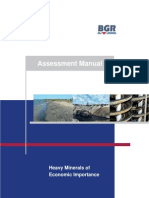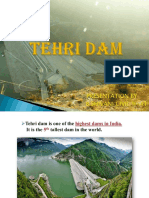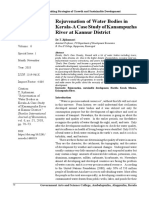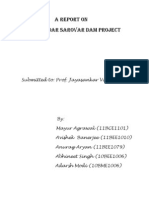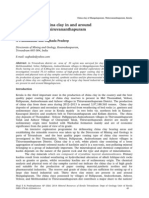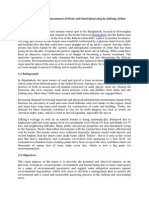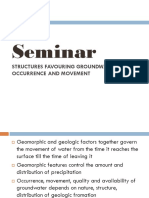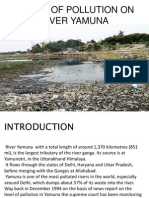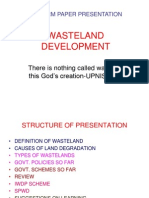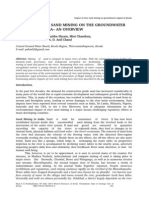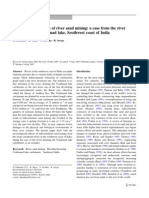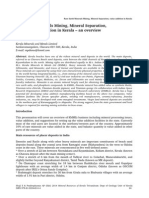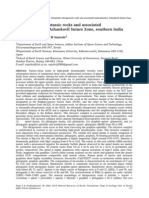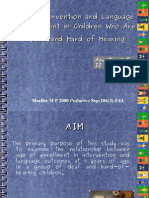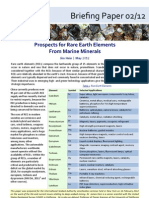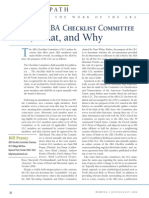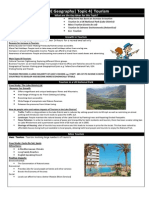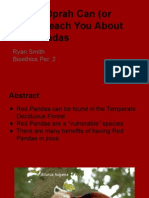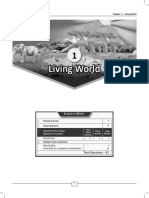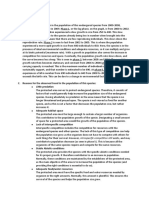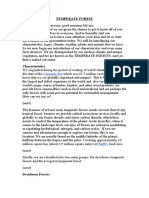Environmental Effects of River Sand Mining: A Case Study of Periyar River, Kerala, Southwest India Shiekha E John, K Maya and D Padmalal Centre For Earth Science Studies, Trivandrum
Environmental Effects of River Sand Mining: A Case Study of Periyar River, Kerala, Southwest India Shiekha E John, K Maya and D Padmalal Centre For Earth Science Studies, Trivandrum
Uploaded by
S.Alec KnowleCopyright:
Available Formats
Environmental Effects of River Sand Mining: A Case Study of Periyar River, Kerala, Southwest India Shiekha E John, K Maya and D Padmalal Centre For Earth Science Studies, Trivandrum
Environmental Effects of River Sand Mining: A Case Study of Periyar River, Kerala, Southwest India Shiekha E John, K Maya and D Padmalal Centre For Earth Science Studies, Trivandrum
Uploaded by
S.Alec KnowleOriginal Title
Copyright
Available Formats
Share this document
Did you find this document useful?
Is this content inappropriate?
Copyright:
Available Formats
Environmental Effects of River Sand Mining: A Case Study of Periyar River, Kerala, Southwest India Shiekha E John, K Maya and D Padmalal Centre For Earth Science Studies, Trivandrum
Environmental Effects of River Sand Mining: A Case Study of Periyar River, Kerala, Southwest India Shiekha E John, K Maya and D Padmalal Centre For Earth Science Studies, Trivandrum
Uploaded by
S.Alec KnowleCopyright:
Available Formats
Shieka E J et al.
Environmental effects of river sand mining, Kerala
Environmental effects of river sand mining: a case study of Periyar river, Kerala, southwest India
Shiekha E John, K Maya and D Padmalal
Centre for Earth Science Studies, Trivandrum 695031, Kerala, India E-mail: shiekha07@gmail.com Abstract. Sand and gravel are the most important aggregate materials used for the construction of roads,
buildings, and other civil works. Rapid urbanization and population growth in the past few decades have induced an exponential rise in the extraction of sand and gravel from river environments. The problem is acute in the state of Kerala in southwest (SW) India as the rivers are small (i.e., with catchment area < 10,000 km 2) with limited river bed resources in their active channels. Many rivers do not have adequate quantity of sand and gravel in their active channels to minimize hungry water effect (energy of the sediment-starved water) of the high flow regime, especially in the monsoon season. This in turn imposes heavy damages on the natural and man-made structures/features associated with the river systems causing huge revenue losses in every monsoon season. Apart from this, the activity imposes irreparable and often irreversible damages to the flora and fauna, surface and groundwater regimes, channel protection structures, etc. of the river systems. Lack of adequate knowledge on the adversities of sand mining is a major setback challenging regulatory measures. Here we report the environmental impacts of sand mining in one of the important rivers of Keralathe Periyar river, an exampleto highlight the significance of the issue. On an average, 5.657 million ty-1 of sand is being extracted from the main channels and 0.979 x 106 ty-1 from the tributary/distributary systems of the Periyar river basin (PRB). The quantity of sand mining from the alluvial reaches in the midlands and lowlands of PRB amounts to 5.9 million ty -1, which is manifold higher than the natural replenishments. The analysis of Central Water Commissions river gauge data shows that the river bed has lowered to about 7.4 m during the period 19802010, with an average channel incision of 24.66 cmy -1. The situation demands high priority and specific policy interventions to restore the natural riverine character of this fluvial system following definite guidelines that regulate and control river sand mining within the resilience capacity of the system.
Keywords: River sand mining, Impacts of sand mining, Hungry waters, Southwest India Introduction A river is a dynamic system that together with its floodplain constitutes a single hydrogeomorphic unit characterized by continuous transfer of water and sediment from the headwaters to the depocentres (Kondolf, 1997; Batalla, 2003). Mans understanding of the structure and functions of river ecosystems has increased considerably in the last few decades. However, it is unfortunate that rivers are still the victim of human greed and interferences. Among the different kinds of interferences, indiscriminate sand and gravel mining is a destructive activity threatening river ecosystem structure and functions. (Kondolf, 1994). Though sediment scooping from channels is an effective tool for ood control in aggrading rivers, its result is dramatic in incising rivers (Wyzga, 2001). The latter is very significant if one considers the case of small rivers of Kerala with basin area <10,000 km 2 (Milliman and Sivitzki, 1992). The unabated sand extraction over the past 45 decades has already imposed irreversible damages to the environmental sub-components of Kerala rivers. The fast pace of economic development, rise in foreign remittances, and liberalized banking policies were responsible for the construction boom of the 1970s that inevitably promoted indiscriminate river sand mining in Kerala (Padmalal et al., 2008; Sreebha and Padmalal, 2011). Although the state is drained by many rivers, the net river bed resources are very limited, while the magnitude of sediment extraction shoots up exponentially over the years leading to severe channel degradation and incision. Unabated instream mining from rivers directly alters the channel geometry and bed elevation, which disrupts the continuum of sediment transport
Shaji E & Pradeepkumar AP (Eds) 2014 Mineral Resources of Kerala Trivandrum: Dept of Geology Univ of Kerala ISBN 978-81-923449-0-4 115
Shieka E J et al.
Environmental effects of river sand mining, Kerala
process (Gaillot and Piegay, 1999). If the continuity of sediment transport is interrupted in a fast flowing river, the excess energy for sediment movement will be used for degrading the fluvial system (Kondolf, 1997). Such degradation due to hungry water effect (energy of the sediment-starved water) leads to a host of problems such as bed degradation, lateral channel instability (Bravard et al., 1997; Kondolf, 2000; Lu et al., 2007; Sreebha and Padmalal, 2011), and finally, water table lowering (Mas-Pla et al., 1999; Prasad and Nair, 2004), ood ow increase, undermining of infrastructure (Bull and Scott, 1974; Kondolf, 1997), sea water ingression, delinking of the connectivity between the main channel and the riparian wetlands (Rinaldi et al., 2005), coarsening of bed material, destruction of spawning and breeding habitat for fishes like salmon and trout (Kitetu and Rowan, 1997; Rinaldi et al., 2005; Arun et al., 2006), and several other biological and environmental impacts.
Table 1 Salient Features of the Periyar River
Sl. No . 1. 2. 3. 4. 5. 6. 7. 8. 9. 10. 11.
River characteristics/parameters River type Head water elevation (m above MSL)/ origin Population Rainfall (mm y-1) River length (km) Basin area (km2) Stream flow (mm3 y-1) River length down the gauging station (km) Sand mining below the gauging station (*106ty1) Total sediment discharge (*106ty1) Total sand discharge (*106ty1)
Specifications/ values Mountainous 1830/ Sivagiri hills 1481305 3200 244 5398 4868 50 4.00 0.37 0.08
Reports reveal that Kerala rivers are fast degrading due to channel incision at a rate of 518 cmy-1 (CESS, 2007; 2010; 2011). This has severe implications for river management, as the small rivers of Kerala have seen a dramatic depletion of sediment uxes due to the combined effects of sediment mining and embankments over the recent decades.
Study area
The state of Kerala in the southwest coast of India has 41 west flowing small catchment rivers. These rivers empty into the Arabian Sea either directly or through coastal lagoons and/or backwater systems. The Periyar river (river length244 km; catchment area5398 km 2) plays an important role in the economic, religious, traditional, and cultural heritage of the state (Fig. 1). But the river is on the verge of severe deterioration due to indiscriminate scooping of sand to meet the ever growing developmental needs of the state over the years. The Periyar river hosts one of the fastest developing urban centres of South IndiaKochi city and its satellite townships which demand huge volumes of building materials including sand for constructions. The water and sediment discharges through the Periyar river are 6,895 MCM and 3.2 lakh tonnes, respectively. The river originates from Sivagiri peak in the Western Ghats, at an elevation of 2,438 m above msl. Geologically, a major part of the Periyar river basin is composed of crystalline rocks of Archaean age with charnockites, charnockite gneiss, hypersthene-diopside
Shaji E & Pradeepkumar AP (Eds) 2014 Mineral Resources of Kerala Trivandrum: Dept of Geology Univ of Kerala ISBN 978-81-923449-0-4 116
Shieka E J et al.
Environmental effects of river sand mining, Kerala
gneiss, hornblende gneiss, and hornblende-biotite and quartz-mica gneiss/biotite gneiss (composite) rock types. These crystalline rocks are intruded at many places by quartzite, pyroxene granulite, and calc granulite. Sedimentary formations ranging in age from Miocene (subsurface occurrence) to Sub-Recent overlie the crystallines along the coastal tract. The entire basin area falls under three broad physiographical units: the highland (>75 amsl), midland (75 8 amsl), and lowland (<8 amsl). Of these, the former two units cover more than 85% of the entire study area. Table 1 summarises some of the salient features of the Periyar River Basin.
Methodology Rivers are said to possess long memories, meaning the channel adjustments to
instream extraction or comparable perturbations may persist long after the activity has practically ceased (Kondolf, 1998). Therefore, assessment of the impact of sand mining on various environmental components of river ecosystems is often difficult as the adverse impacts will not be readily felt at measurable levels as it requires a decade or more period of time to
Fig. 1 Sand mining locations in Periyar river draining the central part of Kerala state, SW India. A substantial part of the sand extracted from the midland reaches is used for meeting the demand in the construction sector of Kochi city.
surface (Kondolf et al., 2002). Hence, a method that involves original investigations to document the existing environmental conditions and the available secondary data on the activity in Periyar river are appropriately blended to achieve the key objectives of the study. The study includes extensive eld surveys in the entire channel networks of the Periyar River Basin for: (1) mapping locations of instream and oodplain sand mining, sand storing centres, reaches of river
Shaji E & Pradeepkumar AP (Eds) 2014 Mineral Resources of Kerala Trivandrum: Dept of Geology Univ of Kerala ISBN 978-81-923449-0-4 117
Shieka E J et al.
Environmental effects of river sand mining, Kerala
bank degradation, locations of civil engineering structures like bridges, etc. and (2) collection of primary and secondary data on mining operations, quantity of sand and gravel extracted from each location, and other relevant information of the river basin. The current extraction of sand from the river stretches falling within the river basin was estimated from number counts and select weighing of the loaded vehicles moving out of the mining locations during the period of sand extraction, interviews with local people and labourers, secondary information available with the district and local administration, etc. using standard formats. The data on discharge of sediment and river bed lowering was collected from the river gauging stations of the Central Water Commission (CWC), Government of India. The data collected through the major research programmes of Centre for Earth Science Studies (CESS) and Centre for Water Resource Development and Management (CWRDM), Department of Mining and Geology, Government of Kerala, Non-Governmental Organisations (NGOs) etc. were the other sources of information for the present study.
Methods of River Sand Mining
Periyar river is subjected to rampant sand mining all along the main channel as well as the tributary/distributary systems, although the natural replenishment of sand by crustal weathering is very meager in the basin. The study reveals that in addition to mining of sand and gravel from active channels (instream mining), a substantial amount of sand is also being extracted from the overbank areas (oodplain mining) of the river as well. Generally, two types of instream mining are practised in the regionpit excavation and bar skimming (Padmalal et al., 2008). Pit excavation is uncontrolled digging /extraction of sand and gravel from the riverbed or oodplain areas by mechanical (i.e., using bulldozers, scrapers, loaders, etc.) or manual means and can further be classified into dry pit and wet pit mining. In wet pit mining, the depth of the excavation pit crosses the groundwater table, whereas in dry pit mining, extraction of sand is limited within the upper dry bed. In some cases, diesel powered suction pumps are used to extract sand rich sediments from wet pits in the active channels and oodplains. Dry pits are often left with abrupt upstream margins. These abrupt margins act as headcuts during high flow seasons, which propagate upstream causing damages to the natural and man-made structures/features associated with river channels.
Table 2 Quantity of Sand Mining (QSM), Labour Force (LF) and number of Sand Mining Sites (SMS) in the Periyar river. T = Tributary ! = !istributary M" = Main channe# ty$% = tonnes &er year.
District/ Physiography Number of local bodies Area (km )
2
QSM (x 106 ty-1) T/D MC 0.33 5.31 -
LF (Number) T 899 2060 MC 906 750 -
SMS (Number) T 129 65 MC 63 100 -
Highland Midland Lowland
19 12 9
1946.13 396.59 146.51
0.326 0.653
Bar scalping or skimming, on the other hand, is the controlled extraction of river bed materials, especially sand and gravel, from the top of the exposed sand bars (instream bars and point bars). The surface irregularities, if any, present in the sand bar will be smoothened in this process and the extracted material will be limited to what could be taken above an imaginary
Shaji E & Pradeepkumar AP (Eds) 2014 Mineral Resources of Kerala Trivandrum: Dept of Geology Univ of Kerala ISBN 978-81-923449-0-4 118
Shieka E J et al.
Environmental effects of river sand mining, Kerala
line sloping upwards and away from water with respect to a specified level above the river water surface at the time of extraction (Kondolf et al., 2002). Bar skimming is usually practiced every
Table 3 'm&act of river sand and grave# mining on various environmenta# com&onents of the study area.
System/ components River channel
Sl.No. 1.
Effects of river sand mining Erosion of riverbanks; riverbank slumping; lowering of river channels; changes in riverbed configuration; channel widening; undermining of engineering structures like bridges, collapse of water intake structures, side protection walls, spillways, etc.; loss of placer mineral resources associated with alluvial sand and gravel. Rise in suspended particulate level, turbidity and other pollutants like oils, grease, etc., from vehicles used for the removal of sands; ponding of water and reduction in natural cleansing capacity of river water; aggravated salt water ingression. Lowering of ground water table in areas adjacent to mining sites; damage to the fresh water aquifer system in areas close to the river mouth zones. Dwindling of floral and faunal diversity within river basin; decline in terrestrial insects like mayfly, dragon fly, stone fly etc., whose larval stages are in the shallow water sandy fluvial systems; habitat damage / loss and changes in breeding and spawning grounds; reduction in inland fishery resource. Damage to culturally significant places; places of annual religious congregations, etc.; creates positive socio-economic impacts in the area through employment and revenue generations for suppliers of goods and services.
2.
Surface water
3. 4.
Ground water Flora and fauna
5.
Socioeconomical
year based on the rate of deposition of sediments. To maintain the hydraulic control provided upstream by the riffle head, the preferred method of bar skimming is now generally to leave the top one-third of the bar undisturbed. Mining is confined only to two-third portion in the downstream end of the bar. Of the two types, pit excavation is the widespread sand mining method adopted in the alluvial reaches of the study area.
Results
Instream mining. Instream sand deposits are easily accessible, well sorted, and normally have low content of fine particles such as silt and clay; hence they are extensively used in the construction industry for concreting and plastering. Rampant instream sand mining is noticed in the PRB (6.636 x 106 ty-1), which is many times higher than that of other rivers in Kerala. The annual instream sediment extraction was 6.636 x 106 ty-1, in which 5.657 x 106 ty-1 was extracted from the main channel and 0.979 x 106 ty-1 from tributary/distributary systems (Table 2). However, the alluvial reaches of the main channels, especially in the midlands, are the most affected by the activity as the quantity of sand mined is about 7 to 8 times higher than the other physiographic zones (midlands: 5.315 x 106 ty-1; highlands: 0.707 x 106 ty-1; lowlands: 0.653 x 106 ty-1). Spatial analysis reveals that about 80% of the extracted sand is from the midlands, which cover only 13% of the entire study area. Various local bodies of Idukki (17), Ernakulam (21), and Thrissur (2) districts that fall within the basin area were engaged in sand mining activities, with the highest demand met by Ernakulam district. The rampant increase in sand extraction noticed in the Periyar river draining Ernakulam district and its peripheral areas is in direct response to the rising demand of sand for the booming construction sector of Kochi city.
Shaji E & Pradeepkumar AP (Eds) 2014 Mineral Resources of Kerala Trivandrum: Dept of Geology Univ of Kerala ISBN 978-81-923449-0-4 119
Shieka E J et al.
Environmental effects of river sand mining, Kerala
The labour force engaged in sand mining activity in the entire basin was estimated to be about 8,975. The locations of sand mining in Periyar river are given in Fig. 1. The highlands and lowlands account for almost an equal amount of sand extraction (Table 2), although the former covers a greater portion of the study area (86%) than the latter (<1%). Twelve local bodies were engaged in sand mining from the midland part of the river that together extract an amount of 5.315 x 106 ty-1 of sand from the river system. The maximum quantity of sand extracted by a local body in the midland was 0.96 x 10 6 ty-1, whereas the minimum was estimated to be 0.019 x 106 ty-1. A total of 5,500 labourers were working in the 100 sand mining locations identified in the midland reaches of the PRB (main channel). In the lowlands, a total of nine local bodies were engaged in sand mining from the river. An amount of 0.653 x 106 ty-1 of sand was extracted from the two distributary channels of the river, namely, Mangalapuzha (0.533 x 106 ty-1) and Marthandavarma (0.12 x 106 ty-1) distributaries. Sand mining activity in the highlands was in much lesser dimensions compared to the midland regions. Out of 19 local bodies involved in sand mining in the highland region, 12 local bodies extract sand from the alluvial deposits of the MunnarPeermedu plateau. A total of about 1,805 labourers are employed in the sand mining sector in the 192 sand mining locations in the highlands. A total amount of 0.177 x 106 ty-1 of sand was extracted from the tributaries and 0.15 x 106 ty-1 from the main river channel in the highland areas. The quantity of sand mining from the alluvial reaches in the midlands and lowlands of PRB amounts to 5.9 million ty -1, which is many folds higher than the natural replenishments (0.08 million ty -1) estimated at the Central Water Commissions gauging stations. Floodplain Mining. In addition to mining of sand and gravel from the active channels (instream mining), a significant quantity of sand has been extracted from the floodplains/overbank areas of the river as well. Floodplains and terraces (former floodplains) are the sites of sediment storage and contain large quantities of sand and gravel within it. The floodplain sand is extracted usually by the pit excavation method. Pits in the floodplains are often deepened below the water table as they provide a convenient water source for the separation of desirable sizes of aggregate materials. In PRB, floodplain mining is noticed in a few locations in the lowlands. Additionally, land sand mining from the paddy lands is noticed in the plateau region of the highlands. It is estimated that about 0.042 x 10 6 ty-1 of sand is mined from the overbank area in the midlands and lowlands of the Periyar river basin.
Discussion
The Periyar river is the lifeline of Central Kerala. The river provides drinking water to several lakhs of people in the area. But the river is on the brink of severe degradation due to indiscriminate scooping of sand over the years (Table 3). The demand for construction grade sand is rising exponentially due to the fast pace of industrialization, urbanization, and associated developments in the region. Studies reveal that the creation of deep pits as well as ponding of water within river channels and floodplain areas, migration of pits and subsequent undermining of side protection walls and other engineering structures etc., are frequent in the storage zones of the river in the mining-hit areas. Bank erosion, bank retreat, and river bank slumping are frequently noticed in the river stretches, especially in the midland and lowland physiographic units where river sand extraction is at an alarming rate. In addition, the illegal and excessive sand mining in the riverbed has led to severe depletion of groundwater. As groundwater is streamfed especially during the summer season, the fall in riverbed level imposes a fall in water level as well. The problems will be complicated further when the water level touches the thick impervious stratum that links the river channel and the floodplains. Water tables have dropped dramatically and a land once known for its plentiful rice harvest now faces scarcity of water and falling food production even in monsoons. Instream mining results in channel instability through direct disruption of pre-existing
Shaji E & Pradeepkumar AP (Eds) 2014 Mineral Resources of Kerala Trivandrum: Dept of Geology Univ of Kerala ISBN 978-81-923449-0-4 120
Shieka E J et al.
Environmental effects of river sand mining, Kerala
channel geometry or through the effects of incision and related undercutting of banks. Of the two types of sand mining described earlier, pit excavation is more dangerous than bar skimming leading to severe bed degradation. Bed degradation occurs through two primary means: headcutting and hungry water effects. In the first case, excavation of a mining pit in the active channel lowers the stream bed, creating a nick point which leads to local steepening of the channel system (Kondolf, 1998). During high flows, the nick point becomes the foci of bed erosion, which gradually moves upstream through headcutting (Bull and Scott, 1974; Kondolf, 1997). Headcuts often move long distances upstream and in severe cases even into the tributaries (Kondolf, 1997). While pit excavation locally increases the channel depth by creating deep pools within the river channel, bar skimming widens the river channel. Both conditions lead to slower stream flow velocities, which in turn lowers the flow energy of river water causing the incoming sediments to be deposited in the mining pits. As the amount of transported sediments leaving the site is less compared to the sediment carrying capacity of the river water, the flow energy increases significantly in response to the normal channel flow. Such energized river waters that emerge from the mining pit are often referred to as hungry water. The hungry water accommodates its fury by eroding more materials from the stream reach below the mining site, causing bed degradation in the downstream areas. This condition continues till a balance between input and output of sediments is re-established (Williams and Wolman, 1984; Kondolf, 1997). The interplay of these two processes of bed degradation and consequent channel incision is visible even in the mining prohibited areas of bridges, water intake units, and other engineering structures that are constructed to protect river environments. Maintaining equilibrium channel size and sinuosity requires that the sediment transport capacity of the channel is, on average, matched to the supply from upstream, so that over the long term the channel neither degrades nor aggrades. Channel-forming processes are most effectively conducted by the flow that transports most sediment load over time. Sediment-starved (hungry water) condition induced by human imposed modifications such as indiscriminate sand mining and construction of impoundments causes incision of the channel bed consequent to paucity of sediment supply (Sreebha, 2008). A systematic analysis was conducted to assess the temporal changes in the cross-sectional profiles of the Periyar river from 1980 to 2010. The records of water and sediment discharges from river gauging stations provide ample evidence of river bed changes/channel incision during the past 23 decades. PRB draining Kochi city records a high bed lowering value (24.66 cmy1), which is a direct response to the uncontrolled sand extraction for meeting developmental requirements. This is in agreement with the reports of Sreebha (2008). The cross-profile measurements of the PRB (CWC gauging stationNeeleswaram) revealed that the channel bed in the river storage zones has lowered to significant levels (7.4 m during the period 19802010) due to indiscriminate sand mining over the years (Fig. 2). The magnitude of channel response to sand extraction depends mainly on the quantity of sand extraction in relation to sand replenishment. The natural replenishment is very meager in the PRB as it is mainly composed of Precambrian crystallines. Further, a substantial part of sand from natural crustal weathering is detained within the reservoirs constructed in the uplands for irrigation and hydropower generation. According to Nair and Padmalal (2006), sand that reaches the alluvial zones is derived from erosion/slumping of earlymiddle Holocene sand layers interbedded within the river banks of the midlands and lowlands. It is well established that when the rate of sand extraction exceeds the replenishment rate, signicant and potentially irreversible changes occur in the hydraulic conditions and channel stability (Kitetu and Rowan, 1997; Kondolf et al., 2002; Sreebha, 2008). Channel incision due to indiscriminate sand mining and pit formation is a threat to even stabilized river banks that derive their strength and resistance to erosion largely from vegetation and to a lesser extent from composition, height, and slope. The river bed lowering in the main channel reduces the number of flood pulse events in the riparian wetlands, mainly because of the increased
Shaji E & Pradeepkumar AP (Eds) 2014 Mineral Resources of Kerala Trivandrum: Dept of Geology Univ of Kerala ISBN 978-81-923449-0-4 121
Shieka E J et al.
Environmental effects of river sand mining, Kerala
height of the river banks due to incision. This automatically leads to drying up of the riparian wetlands and loss of its bioproductivity and ecological integrity. Water level lowering and deepening of the master channels would also reduce the gradient existing between the master channel and water level in riparian wetlands and oxbow or floodplain lakes. The problem will be complicated further by extractive effects of floodplain sand using high power jet pumps.
Fig. 2 Channel cross-prole changes noticed in the Periyar river recorded at the Neeleswaram CWC gauging station. (a) River bed lowering of Periyar river during 19802010; (b) average bed lowering estimated for the entire section; and (c) bed lowering noticed at the deepest point of the channel 80 m away from RP of CWC gauging station. LBLeft bank; RBRight bank; RPReference point. Elevation is measured with respect to mean sea level (MSL). Data source: Central Water Commission, Kochi.
Conclusions
Despite the indisputable significance of rivers in supporting life and greenery of a region, rivers have been widely exploited by humans without understanding much on how these ecosystems maintain their vitality. Rivers are under immense pressure owing to various kinds of anthropogenic activities, among which indiscriminate extraction of sand and gravel is the most disastrous, as the activity threatens the very existence of the river ecosystem. The Periyar river plays an important role in the economic, religious, traditional, and cultural heritage of the state. The river is subjected to rampant sand mining all along the main channel as well as the tributary/distributary systems leading to severe deterioration of the fluvial network. The study revealed that the mining activity is a major threat to the very existence of the Periyar river, in particular, and the small rivers, in general, which have degraded considerably over the past few
Shaji E & Pradeepkumar AP (Eds) 2014 Mineral Resources of Kerala Trivandrum: Dept of Geology Univ of Kerala ISBN 978-81-923449-0-4 122
Shieka E J et al.
Environmental effects of river sand mining, Kerala
decades. The river degradation is severe in the alluvial reaches of the midlands followed by lowlands compared to the production zones in the highlands. This is because a greater proportion of sand is extracted from the midland part of the Periyar river, in spite of a lesser number of sand mining locations, compared to the other two physiographic zonesthe highlands and lowlands. This is in direct response to the rising demand of sand for the fast developing urban centres in the midland area, especially Kochi city. In some cases, the river
Fig. 3 Revenue collection from the extraction of minerals (major and minor) in Kerala. (a) Revenue collection for the period 1985/862009/10; (b) Production of minor minerals during 2006. Data source: Mining and Geology, Government of Kerala.
bank itself is being scooped out first for brick earths and then the intervening sand layers for fine aggregates, because of the massive demand in the construction sector. As the sand and gravel resources are extracted easily from the in-channel or flood plain sources, people depend on the river sources of sand greatly compared to other aggregate sources (Fig. 3). This has altered
Shaji E & Pradeepkumar AP (Eds) 2014 Mineral Resources of Kerala Trivandrum: Dept of Geology Univ of Kerala ISBN 978-81-923449-0-4 123
Shieka E J et al.
Environmental effects of river sand mining, Kerala
considerably the river systems and the channel hydraulics in addition to the reduction of productivity within the in-channel and flood plain areas. It is unfortunate that legislation and public interest have failed to restrict indiscriminate sand mining and also to arrest channel incision and drying up of the riparian wetlands used mainly for paddy cultivation. As a result of sediment mining, the river has experienced remarkable channel adjustments, particularly incision and narrowing in bar built area, channel widening, etc. The situation demands for high priority and specific policy interventions to restore the natural riverine character of the already disfigured rivers of the state. In this context, the role of the government and communities is extremely important not only to ameliorate the situation but also to sustain both economic and environmental quality of river systems of the state.
Management Options and Extraction Control Measures
The most effective way to protect, or restore the health and stability of rivers is by protecting naturally occurring physical processes that create and maintain these systems. Rivers can be protected from the negative impacts of dredging by implementing a combination of two methods that minimize the disturbance of stream channel: (1) minimizing channel modifications and (2) limiting the volume of sediment extraction below the level of natural replenishments. It is important that sediment extraction operates at scales that do not intercept the quantity of coarse sediment supply. Providing for a positive sediment budget downstream from sand mining areas of a river is a fundamental requirement for the sustainability of ecological functions. Several researchers have reported different methods to control sediment extraction from rivers. Kondolf (1994) opined that aggregate extraction from rivers must be managed on a river basin scale, while the demand for aggregate and its supply must be managed on a productionconsumption basis. According to Kondolf et al. (2002), one strategy is to define a redline, a minimum elevation for the thalweg along the river, and to permit dredging so long as the bed does not incise below this line. This can be verified by yearly or half yearly river bed surveys by expert groups. The channel bars constitute a renewable resource of sand and gravel, which can be harvested without damage to the channel if proper care is taken while implementing the sand extraction processes. Aggregate management should be considered separately from river management. Separate legislations are required for this purpose. This is to ensure continuous supply of high quality sand for constructions on one hand and to protect rivers from indiscriminate sand mining on the other. Proper inventory of the available sand resources and sediment replenishment through sand auditing should be made mandatory prior to sanction of leases. References
Arun P. R., Sreeja R., Sreebha S., Maya K., and Padmalal D. (2006). River sand mining and its impact on physical and biological environments of Kerala rivers, Southwest coast of India. Eco-chronicle, Vol. 1, pp. 16. Batalla R. J. (2003). Sediment deficit in rivers caused by dams and instream gravel mining. A review with example from NE Spain, Revista C. & G., Vol. 17 (34), pp. 7991. Bravard J. P., Amoros C., Pautou G., and others (1997). River incision in South-east France: Morphological phenomena and ecological effects. Regulated rivers: Research & Management, Vol. 13, pp. 7590. Bull W. B. and Scott K. M. (1974). Impact of Mining Gravel from Urban Stream Beds in the Southwestern United States. Journal of Geology, Vol. 2, pp. 171174. CESS (2007). River sand mining and management. Brochure. CESS (2010). Environmental appraisal and sand auditing of Manimala river, Kerala, India. Project report, CESS-PR05-2010. CESS (2011). Environmental appraisal and sand auditing of Periyar river, Ernakulam district, Kerala. Project report, CESS-PR-02-2011.
Shaji E & Pradeepkumar AP (Eds) 2014 Mineral Resources of Kerala Trivandrum: Dept of Geology Univ of Kerala ISBN 978-81-923449-0-4 124
Shieka E J et al.
Environmental effects of river sand mining, Kerala
Gaillot S. and Piegay H. (1999). Impact of gravel mining on stream channel and coastal sediment supply: Example of the Calvi Bay in Corsica (France). Journal of Coastal Research, Vol. 15 (3), pp. 774788. Kitetu J. and Rowan J. (1997). Integrated environmental assessment applied to river sand harvesting in Kenya: In sustainable development in a developing world Integrated socio economic appraisal and Environmental Assessment, Patric C K and Lee N (Eds.), Edward Elgar, Cheltenham (U.K.), pp. 189199. Kondolf G. M. (1994). Environmental planning in regulation and management of instream gravel mining in California, Landscape and Urban Planning, Vol. 29, pp. 185199. Kondolf G. M. (1997). Hungry Water: Effects of dams and gravel mining on river channels. Environment Management, Vol. 21, pp. 533551. Kondolf G. M. (1998). Large scale extraction of alluvial deposits from rivers in California: Geomorphic effects and regulatory strategies. In: Gravel bed rivers in the environment, Klingeman P C, Beschta R L, Komar P D, and Bradley J B (eds.), Water Resources Publications, Colorado, pp. 455470. Kondolf G. M. (2000). Assessing salmonid spawning gravels. Transactions of the America Fisheries Society, Vol. 129, pp. 262281. Kondolf G. M., Smeltzer M., and Kimball L. (2002). Freshwater gravel mining and dredging issues. Report prepared for Washington department of fish and wildlife, Washington department of ecology and Washington department of transportation, p. 122. Lu X. X., Zhang S. R., Xie S. P., and Ma P. K. (2007). Rapid channel incision of the lower Pearl river (China) since the 1990s as a consequence of sediment depletion. Hydrology and Earth System Sciences, Vol. 11, pp. 1897 1906. Mas-Pla J., Montaner J., and Sola J. (1999). Groundwater resources and quality variations caused by gravel mining in coastal streams. Journal of Hydrology, Vol. 216 (34), pp. 197213. Milliman J. D. and Syvitski J. P. M. (1992). Geomorphic/tectonic control of sediment discharge to the ocean: The importance of small mountainous river. Journal of Geology, Vol. 100, pp. 525544. Padmalal D., Maya K., Sreebha S., and Sreeja R. (2008). Environmental effects of river sand mining: A case from the river catchments of Vembanad lake, Southwest coast of India. Environment Geology, Vol. 24, pp. 879889. Prasad R. R. and Nair K. M. (2004). Integrated hydrogeological investigations and multipronged water conservation in selected watershed of Achankovil river basin. Report of Peoples Research Organisation for Grass Root Environmental Science Service (Progress), Hyderabad, p. 43. Rinaldi M., Wyzga B., and Surian N. (2005). Effects of sediment mining on channel morphology and environment in alluvial rivers. River Research and Application, Vol. 21, pp. 805828. Sreebha S. (2008). Environmental impact of sand mining: A case study in the river catchments of Vembanad lake, Southwest India. Ph.D. Thesis (Unpubl.), Cochin University of Science and Technology, Kochi. Sreebha S. and Padmalal D. (2011). Environmental impact assessment of sand mining from the small catchment river in the southwestern coast of India. Environmental Management, Vol. 47, pp. 130140. Williams G. P. and Wolman M. G. (1984). Downstream effects of dams on alluvial rivers. US Geological Survey Professional Paper, Vol. 1286, p. 89. Wyzga B. (2001). Impact of the channelization-induced incision of the Skawa and Wisloka rivers, southern Poland, on the conditions of overbank deposition. Regulated Rivers: Research and Management, Vol. 17, pp. 85100.
Shaji E & Pradeepkumar AP (Eds) 2014 Mineral Resources of Kerala Trivandrum: Dept of Geology Univ of Kerala ISBN 978-81-923449-0-4 125
You might also like
- Cannoly CanalDocument15 pagesCannoly CanalArya SreeNo ratings yet
- Heavy Minerals Economic Placers Sediment Book HARALD ELSNERDocument222 pagesHeavy Minerals Economic Placers Sediment Book HARALD ELSNERS.Alec Knowle100% (2)
- Impact of clay mining on the ground water regime in parts of Thiruvananthapuram district, Kerala Mini Chandran1, T. S. Anitha Shyam1, P . Nandakumaran1, E. Shaji2 1Central Ground Water Board, Kerala RegionDocument11 pagesImpact of clay mining on the ground water regime in parts of Thiruvananthapuram district, Kerala Mini Chandran1, T. S. Anitha Shyam1, P . Nandakumaran1, E. Shaji2 1Central Ground Water Board, Kerala RegionS.Alec Knowle100% (1)
- Tehri DamDocument15 pagesTehri DamBanala shivaniNo ratings yet
- Rejuvenation of Water Bodies in Kerala-A Case Study of Kanampuzha River at Kannur DistrictDocument4 pagesRejuvenation of Water Bodies in Kerala-A Case Study of Kanampuzha River at Kannur DistrictAnshuman SinghNo ratings yet
- Ground Water Levels in MumbaiDocument13 pagesGround Water Levels in MumbaiAndwark100% (1)
- Sardar Sarovar Dam Final ReportDocument32 pagesSardar Sarovar Dam Final ReportAnurag Aryan67% (6)
- Water Supply, Sanitation and Hygiene Situation in UjjainDocument18 pagesWater Supply, Sanitation and Hygiene Situation in Ujjainrahul banerjee100% (1)
- Exploration For China Clay in and Around Mangalapuram, Thiruvananthapuram District, Kerala A Prabhakumar and Sughada Pradeep Directorate of Mining and GeologyDocument9 pagesExploration For China Clay in and Around Mangalapuram, Thiruvananthapuram District, Kerala A Prabhakumar and Sughada Pradeep Directorate of Mining and GeologyS.Alec Knowle100% (3)
- Chiplun Case StudyDocument26 pagesChiplun Case Studymohsina InamdarNo ratings yet
- Topography and Geology - PuducheryDocument22 pagesTopography and Geology - PuducherysathyamreNo ratings yet
- Bihar Kosi Floods 2008Document13 pagesBihar Kosi Floods 2008PrachiNo ratings yet
- Polluted SiteDocument14 pagesPolluted SiteDineshNo ratings yet
- Narmada DamFinalDocument24 pagesNarmada DamFinalShilpa Ingle100% (7)
- DSRDocument181 pagesDSRJATIN NEGI100% (1)
- Geological Survey of M.PDocument130 pagesGeological Survey of M.PAkash Yadav50% (2)
- Char Dham ProjectDocument1 pageChar Dham ProjectkishoresutradharNo ratings yet
- Bhuj Earthquake India: Presented by - Animesh Jaiswal B.Arch 3 YR Foap, AktuDocument54 pagesBhuj Earthquake India: Presented by - Animesh Jaiswal B.Arch 3 YR Foap, AktuAnimesh JaiswalNo ratings yet
- Government of Maharashtra: Water Resources DepartmentDocument160 pagesGovernment of Maharashtra: Water Resources DepartmentEknath TaleleNo ratings yet
- Science 2: Water Pollution and Air PollutionDocument11 pagesScience 2: Water Pollution and Air PollutionNikita MundeNo ratings yet
- Disaster - West Bengal FloodDocument11 pagesDisaster - West Bengal FloodAastha ShrivastavaNo ratings yet
- TripuraDocument21 pagesTripuraPushpa B SridharanNo ratings yet
- Ground Water Provinces of IndiaDocument2 pagesGround Water Provinces of Indiauchiha itachNo ratings yet
- Mineral Based IndustriesDocument16 pagesMineral Based IndustriesnehaNo ratings yet
- What Is A DamDocument4 pagesWhat Is A DamCarl John SedimoNo ratings yet
- Vaigai Study AreaDocument11 pagesVaigai Study AreaSaravanan Subbarayan100% (1)
- Geology and Geography of PuneDocument9 pagesGeology and Geography of PuneDivya AloneyNo ratings yet
- Presentation On Kaleshwaram Project On 02.02.18Document36 pagesPresentation On Kaleshwaram Project On 02.02.18Sadhwick Reddy100% (1)
- Mithi Riverfront DevelopmentDocument18 pagesMithi Riverfront DevelopmentShubhani ChandraNo ratings yet
- Case Study-Malpa Landslide-1998Document4 pagesCase Study-Malpa Landslide-1998Rakshitha Sai100% (1)
- History of IrrigationDocument35 pagesHistory of IrrigationSani Panhwar100% (2)
- Interbasin Water TransferDocument66 pagesInterbasin Water TransferRama PrasadNo ratings yet
- Agro Climatic Zones: State: Himachal PradeshDocument4 pagesAgro Climatic Zones: State: Himachal PradeshAmitNo ratings yet
- Vishwa MitriDocument12 pagesVishwa MitriDashmeet Singh Chhabada100% (1)
- Environmental Impact: Assessment of Stone and Sand Quarrying in Jaflong, SylhetDocument23 pagesEnvironmental Impact: Assessment of Stone and Sand Quarrying in Jaflong, SylhetArif Uz ZamanNo ratings yet
- Sukhomajri Case Study PDFDocument17 pagesSukhomajri Case Study PDFshanki0072015No ratings yet
- Precambrian Stratigraphy of KeralaDocument22 pagesPrecambrian Stratigraphy of KeralaRA H UL100% (2)
- Pallikaranai MarshDocument31 pagesPallikaranai MarshAnand Raj100% (1)
- Case Study of Lakes in BangaloreDocument5 pagesCase Study of Lakes in BangaloreGouthamNo ratings yet
- Ib Valley Jharsuguda 22-10-16Document108 pagesIb Valley Jharsuguda 22-10-16Dev MisraNo ratings yet
- Soils of KeralaDocument3 pagesSoils of Keralasmotjsjs100% (1)
- Reimagining The City Edges Along The Nallah PresentationDocument99 pagesReimagining The City Edges Along The Nallah Presentationjhalak nanawatiNo ratings yet
- Canal Structure KhadakwaslaDocument11 pagesCanal Structure KhadakwaslaPrajyot SapkalNo ratings yet
- Donakonda Development Cluster - Master Planning Framework Dec2016Document18 pagesDonakonda Development Cluster - Master Planning Framework Dec2016Vishwanath SistaNo ratings yet
- Litrature Review On Topography of ChiplunDocument6 pagesLitrature Review On Topography of ChiplunMoin KhotNo ratings yet
- Hill Areas Development Programme (HADP)Document10 pagesHill Areas Development Programme (HADP)Komal MeenaNo ratings yet
- Ganga BasinDocument268 pagesGanga Basinsonuvuce100% (2)
- Rehabilitation Issues and Case Study of Kedarnath LandslideDocument46 pagesRehabilitation Issues and Case Study of Kedarnath Landslidebittumonster5888100% (3)
- Structures Favouring Groundwater Movement and OccurrenceDocument22 pagesStructures Favouring Groundwater Movement and OccurrencecNo ratings yet
- Revival of Mansagar LakeDocument6 pagesRevival of Mansagar LakemonikaNo ratings yet
- Impact of Pollution On River YamunaDocument13 pagesImpact of Pollution On River YamunaAnupriya Sharma100% (7)
- The Challenges of Urbanisation in GoaDocument7 pagesThe Challenges of Urbanisation in GoaShouvik MajumdarNo ratings yet
- Historico-Geographical Settings of Calicut City: Chapter-4Document31 pagesHistorico-Geographical Settings of Calicut City: Chapter-4mufsina k.kNo ratings yet
- Report On Sabarmati Riverfront DevelopmentDocument10 pagesReport On Sabarmati Riverfront DevelopmentPriya Johnson100% (1)
- Report Himachal Pradesh State Geology and Mineral Maps Geological Survey of India 0Document49 pagesReport Himachal Pradesh State Geology and Mineral Maps Geological Survey of India 0Kulbir Thakur33% (3)
- 4.land AcquisitionDocument16 pages4.land AcquisitionSaurabh SinghNo ratings yet
- 12 Wasteland Development 37 (R.R. Parida)Document15 pages12 Wasteland Development 37 (R.R. Parida)nandhinidishNo ratings yet
- Bharat Dangar - Case Study On Vishwamitri RiverDocument42 pagesBharat Dangar - Case Study On Vishwamitri RiverKrutiGDesai100% (1)
- Udaipur LakesDocument9 pagesUdaipur Lakesabhay guptaNo ratings yet
- IMPACT OF RIVER SAND MINING ON THE GROUNDWATER REGIME IN KERALA– AN OVERVIEW P Nandakumaran, T. S. Anitha Shyam, Mini Chandran, V . R. Rani, G. Srinath & A. D. Anil Chand Central Ground Water Board, Kerala RegionDocument9 pagesIMPACT OF RIVER SAND MINING ON THE GROUNDWATER REGIME IN KERALA– AN OVERVIEW P Nandakumaran, T. S. Anitha Shyam, Mini Chandran, V . R. Rani, G. Srinath & A. D. Anil Chand Central Ground Water Board, Kerala RegionS.Alec Knowle100% (2)
- Sand MiningDocument11 pagesSand MiningSandeep K Sandeep100% (1)
- Physico Chemical Characterization of Allanite From Thodupuzha, Kerala K R Baiju, T Amaldev & A S SuiDocument1 pagePhysico Chemical Characterization of Allanite From Thodupuzha, Kerala K R Baiju, T Amaldev & A S SuiS.Alec KnowleNo ratings yet
- Ground Water Conservation in Kerala Policies and Practice With Special Emphasis On Ground Water Conservation in IndiaDocument38 pagesGround Water Conservation in Kerala Policies and Practice With Special Emphasis On Ground Water Conservation in IndiaS.Alec Knowle100% (1)
- Shear Zones and Crustal Blocks of Southern IndiaDocument42 pagesShear Zones and Crustal Blocks of Southern IndiaS.Alec Knowle100% (1)
- Clay Deposits in Ulloor Area of Taliparamba Taluk, Kannur, Kerala Sughada Pradeep Directorate of Mining and GeologyDocument6 pagesClay Deposits in Ulloor Area of Taliparamba Taluk, Kannur, Kerala Sughada Pradeep Directorate of Mining and GeologyS.Alec KnowleNo ratings yet
- Sedimentological studies of beach sand of Tamil Nadu and Kerala coast, India – Implications on provenance and depositional environments D Senthil Nathan & B S Bijilal Department of Earth Sciences, SPCAS, Pondicherry UniversityDocument1 pageSedimentological studies of beach sand of Tamil Nadu and Kerala coast, India – Implications on provenance and depositional environments D Senthil Nathan & B S Bijilal Department of Earth Sciences, SPCAS, Pondicherry UniversityS.Alec Knowle100% (2)
- Marine Sand Resources off Kerala Coast visàvis Acute Shortage of Construction Sand in the State of Kerala A C Dinesh1, P Praveen Kumar2, N M Shareef2 & C Jayaprakash3 Marine & Coastal Survey Division, Geological Survey of IndiaDocument13 pagesMarine Sand Resources off Kerala Coast visàvis Acute Shortage of Construction Sand in the State of Kerala A C Dinesh1, P Praveen Kumar2, N M Shareef2 & C Jayaprakash3 Marine & Coastal Survey Division, Geological Survey of IndiaS.Alec KnowleNo ratings yet
- Impacts of Brick and Tile Clay Mining From The Wetlands of Periyar River Basin, Kerala, India K A Aswathy, Shiekha E John, K Maya and D Padmalal Centre For Earth Science Studies, ThiruvananthapuramDocument8 pagesImpacts of Brick and Tile Clay Mining From The Wetlands of Periyar River Basin, Kerala, India K A Aswathy, Shiekha E John, K Maya and D Padmalal Centre For Earth Science Studies, ThiruvananthapuramS.Alec Knowle100% (1)
- IMPACT OF RIVER SAND MINING ON THE GROUNDWATER REGIME IN KERALA– AN OVERVIEW P Nandakumaran, T. S. Anitha Shyam, Mini Chandran, V . R. Rani, G. Srinath & A. D. Anil Chand Central Ground Water Board, Kerala RegionDocument9 pagesIMPACT OF RIVER SAND MINING ON THE GROUNDWATER REGIME IN KERALA– AN OVERVIEW P Nandakumaran, T. S. Anitha Shyam, Mini Chandran, V . R. Rani, G. Srinath & A. D. Anil Chand Central Ground Water Board, Kerala RegionS.Alec Knowle100% (2)
- Quarrying and Mining Vis À Vis Environmental Concerns in Kerala - Thoughts On Remedial Strategies M P Muraleedharan Geological Survey of IndiaDocument13 pagesQuarrying and Mining Vis À Vis Environmental Concerns in Kerala - Thoughts On Remedial Strategies M P Muraleedharan Geological Survey of IndiaS.Alec Knowle100% (1)
- An Overview of Primary, Supergene and Placer Gold Occurrences of Wayanad-Nilambur Granulitic Terrain, South India Prabhakar Sangurmath The Hutti Gold Mine Company LTDDocument11 pagesAn Overview of Primary, Supergene and Placer Gold Occurrences of Wayanad-Nilambur Granulitic Terrain, South India Prabhakar Sangurmath The Hutti Gold Mine Company LTDS.Alec KnowleNo ratings yet
- Rare Earth Minerals Mining, Mineral Separation, and Its Value Addition in Kerala - An Overview T KarthikeyanDocument6 pagesRare Earth Minerals Mining, Mineral Separation, and Its Value Addition in Kerala - An Overview T KarthikeyanS.Alec KnowleNo ratings yet
- Exploration and Evaluation of Beach Placers of India With Special Emphasis On Kerala A K RaiDocument2 pagesExploration and Evaluation of Beach Placers of India With Special Emphasis On Kerala A K RaiS.Alec KnowleNo ratings yet
- Exploration for china clay in Kadayattu, Puthiyaveedu Padinjattumbhagom, and Kanjirakode area of Mulavana village, Kollam district, Kerala Sughada Pradeep and K N Raman Nampoothiri Directorate of Mining and Geology KeralaDocument25 pagesExploration for china clay in Kadayattu, Puthiyaveedu Padinjattumbhagom, and Kanjirakode area of Mulavana village, Kollam district, Kerala Sughada Pradeep and K N Raman Nampoothiri Directorate of Mining and Geology KeralaS.Alec Knowle100% (1)
- Exploration For China Clay in and Around Mangalapuram, Thiruvananthapuram District, Kerala A Prabhakumar and Sughada Pradeep Directorate of Mining and GeologyDocument9 pagesExploration For China Clay in and Around Mangalapuram, Thiruvananthapuram District, Kerala A Prabhakumar and Sughada Pradeep Directorate of Mining and GeologyS.Alec Knowle100% (3)
- From Flood Geology To Rare Earths Geology K. SomanDocument5 pagesFrom Flood Geology To Rare Earths Geology K. SomanS.Alec KnowleNo ratings yet
- Ultramafic-Ultrapotassic Rocks and Associated Mineralization in Achankovil Suture Zone, Southern India Rajesh VJ, Santosh M, Arai SDocument2 pagesUltramafic-Ultrapotassic Rocks and Associated Mineralization in Achankovil Suture Zone, Southern India Rajesh VJ, Santosh M, Arai SS.Alec KnowleNo ratings yet
- Mineral Resources of Kerala E Shaji and AP PradeepkumarDocument188 pagesMineral Resources of Kerala E Shaji and AP PradeepkumarS.Alec Knowle100% (2)
- Mineral Resources of Kerala: A Tectonic Perspective M Santosh and E ShajiDocument10 pagesMineral Resources of Kerala: A Tectonic Perspective M Santosh and E ShajiS.Alec KnowleNo ratings yet
- MSC Geology Kerala University Entrance Question Paper 2009Document19 pagesMSC Geology Kerala University Entrance Question Paper 2009S.Alec Knowle83% (6)
- Moeller Mary Pat 2000 Early Intervention and Language Development in Children Who Are Deaf and Hard of Hearing PEDIATRICS Vol. 106 No. 3 September 2000Document16 pagesMoeller Mary Pat 2000 Early Intervention and Language Development in Children Who Are Deaf and Hard of Hearing PEDIATRICS Vol. 106 No. 3 September 2000S.Alec KnowleNo ratings yet
- Drvc2011 AbstractsDocument34 pagesDrvc2011 AbstractsS.Alec KnowleNo ratings yet
- Kerala University PHD Entrance Exam QuestionDocument102 pagesKerala University PHD Entrance Exam QuestionS.Alec Knowle100% (1)
- Geology and Mineral Resources of KeralaDocument93 pagesGeology and Mineral Resources of KeralaKishor DeshmukhNo ratings yet
- Tropical Mountains Western Ghats Ecology Expert Panel (WGEEP Report Part I-2), Kerla, India EIADocument171 pagesTropical Mountains Western Ghats Ecology Expert Panel (WGEEP Report Part I-2), Kerla, India EIAS.Alec KnowleNo ratings yet
- Guidebook On Technologies For Disaster Preparedness and Mitigation ISRO Satyabrata SahuDocument102 pagesGuidebook On Technologies For Disaster Preparedness and Mitigation ISRO Satyabrata SahuS.Alec KnowleNo ratings yet
- R IntroDocument109 pagesR IntroHartman József JociNo ratings yet
- Prospects For Rare Earth Elements From Marine MineralsDocument4 pagesProspects For Rare Earth Elements From Marine MineralsThe American Security ProjectNo ratings yet
- 1.3. Structure and Function of EcosystemDocument11 pages1.3. Structure and Function of EcosystemRathnavel Ponnuswami93% (29)
- 2022ecology NeotropicalFishesDatapaperDocument11 pages2022ecology NeotropicalFishesDatapaperHelena ReisNo ratings yet
- ECOSYSTEMDocument38 pagesECOSYSTEMbluedB27100% (1)
- Topic-03 (WATER POLLUTION) : Ques: What Is Water Pollution?/ Define Water Pollution? AnsDocument50 pagesTopic-03 (WATER POLLUTION) : Ques: What Is Water Pollution?/ Define Water Pollution? Ansmizbahulabedin22No ratings yet
- ABA Checklist Committee (Who, What, Why)Document3 pagesABA Checklist Committee (Who, What, Why)BillPrantyNo ratings yet
- Peri Urban Areas: Sustainability Dimension: - Ar. Manita Saxena & Supriya VyasDocument10 pagesPeri Urban Areas: Sustainability Dimension: - Ar. Manita Saxena & Supriya VyasTJPRC PublicationsNo ratings yet
- Darwins Theory of EvolutionDocument11 pagesDarwins Theory of EvolutionFelicia Landon-HicksNo ratings yet
- The Ecology of Rafting in The Marine EnvironmentDocument140 pagesThe Ecology of Rafting in The Marine EnvironmentPedroNo ratings yet
- Bhattacharyaetal 2019 Awareness WorkshopsDocument8 pagesBhattacharyaetal 2019 Awareness WorkshopsEdwinNo ratings yet
- The Demon-Seed, Bioinvasion As The Unsettling of Environmental CosmopolitanismDocument26 pagesThe Demon-Seed, Bioinvasion As The Unsettling of Environmental CosmopolitanismA MNo ratings yet
- Rain Forest Savanna ArticleDocument7 pagesRain Forest Savanna ArticlePrunar FlorinNo ratings yet
- Anthropocentrism: Ecocentrism in Environmental EthicsDocument5 pagesAnthropocentrism: Ecocentrism in Environmental EthicsLawrence TumaponNo ratings yet
- Ecological Literacy in Design EducationDocument12 pagesEcological Literacy in Design EducationLike ItNo ratings yet
- Environmental Movements India 110Document31 pagesEnvironmental Movements India 110Jack Vale100% (1)
- Sustainable Water UseDocument18 pagesSustainable Water UseGiorgio Louis BascoNo ratings yet
- GCSE Geography - Topic 4 - Tourism: What Are The Key Ideas For This Topic?Document3 pagesGCSE Geography - Topic 4 - Tourism: What Are The Key Ideas For This Topic?Sanah KhanNo ratings yet
- Cesc Modules 8Document6 pagesCesc Modules 8kiethly juanitezNo ratings yet
- Passenger PigeonDocument26 pagesPassenger PigeonnikhilNo ratings yet
- Preliminary Site AssessmentDocument4 pagesPreliminary Site AssessmentChristiana Kurt BaliliNo ratings yet
- What Oprah Can (Or Can't) Teach You About Red Pandas: Ryan Smith Bioethics Per. 2Document16 pagesWhat Oprah Can (Or Can't) Teach You About Red Pandas: Ryan Smith Bioethics Per. 2Ryan Benson SmithNo ratings yet
- Environment and SocietyDocument8 pagesEnvironment and SocietyanzaNo ratings yet
- 11th Science Sample PDF - BiologyDocument10 pages11th Science Sample PDF - BiologyRajendra GadilkarNo ratings yet
- National Biodiversity Strategy AND Action Plan N RomaniaDocument57 pagesNational Biodiversity Strategy AND Action Plan N RomaniaMihaela ANTOFIENo ratings yet
- Unit 1evsDocument71 pagesUnit 1evsprashantshakya7217No ratings yet
- Species Management AssignmentDocument2 pagesSpecies Management AssignmentDenisha InglisNo ratings yet
- Government Regulations (PP) No. 57 of 2016Document3 pagesGovernment Regulations (PP) No. 57 of 2016江淑怡No ratings yet
- Temperate ForestDocument4 pagesTemperate ForestCaped BaldyNo ratings yet
- Chris Wold, David Hunter, and Melissa Powers, Climate Change and The LawDocument47 pagesChris Wold, David Hunter, and Melissa Powers, Climate Change and The LawccrissNo ratings yet
- Natural Resources Wildlife ResourcesDocument32 pagesNatural Resources Wildlife ResourcesDev SisodiyaNo ratings yet
- TWS Public Witness Testimony - House Interior Approps - Alan Rowsome 2013. Renewable Energy.Document4 pagesTWS Public Witness Testimony - House Interior Approps - Alan Rowsome 2013. Renewable Energy.The Wilderness SocietyNo ratings yet

